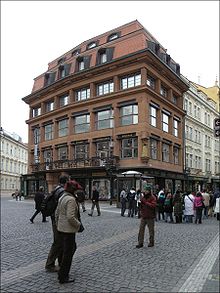- Czech Cubism
-
 Cubist House of the Black Madonna, Prague, Czech Republic
Cubist House of the Black Madonna, Prague, Czech Republic
Czech Cubism was an avant-garde art movement of Czech proponents of Cubism, active mostly in Prague from 1910 to 1914.
Members of this movement realised the epochal significance of the Cubism of Pablo Picasso and Georges Braque and attempted to extract its components for their own work in all branches of artistic creativity - sculpture, painting, applied arts and architecture. The Czech Otto Gutfreund is acknowledged, by the art critic Douglas Cooper (1911-1984), to be the author of the first Cubist sculpture Anxiety (Úzkost in Czech), created in 1911 and exhibited in Paris in 1912.
The most notable participants in this movement were the painters Emil Filla, Bohumil Kubišta, Antonín Procházka, and Josef Čapek, the sculptor Otto Gutfreund, the writer Karel Čapek, and the architects Pavel Janák, Josef Gočár, Vlastislav Hofman and Josef Chochol. Many of these artists were members of the Mánes Union of Fine Arts. A major division in Czech architecture occurred in 1911 when many young avant-garde artists from Jan Kotĕra and his circle divorced themselves from the Mánes Association. These younger architects were more idealistic in their outlook and criticized the strict rationalism of their forebears, Otto Wagner and Kotĕra. Janák, Gočár, and Hofman founded the group Skupina výtvarných umĕlců (Group of Plastic Artists) and established a journal for the group, Umĕlecký mĕsíčník (Artistic Monthly).
After Czechoslovakia's founding in 1918, architectural Czech Cubism gradually developed into Czech Rondocubism, which was more decorative, as it was influenced by traditional folk ornaments to celebrate the revival of Czech national independence.
Contents
The Concept
Czech Cubists distinguish their work through the construction of sharp points, slicing planes, and crystalline shapes in their art works. These angles allowed the Czech Cubists to incorporate their own trademark in the avant-garde art group of Modernism. They believed that objects carried their own inter energy which could only be released by splitting the horizontal and vertical surfaces that restrain the conservative design and “ignore the needs of the human soul.” It was a way to revolt from the typical art scene in the early 1900s in Europe. This evolved into a new art movement. Pyramid and crystal forms were one of the signature principles seen in Czech Cubism which was incorporated in architecture, furniture, and applied arts.
The History
The first signs of Czech cubism came to be in the 1910s. It was a contemporary development of functionalism generated by architects and designers in Prague. Fifteen years prior, the first concept of cubism itself was written off as a decorative purpose, a replacement of secessionism and mistaken departure into ‘aesthetictism’ and ‘individualism’. On the contrary, it was a revolt against traditional values of realism.
Czech cubism was first conceal by the Modern Movement and masked by the aesthetic dictates of Stalinist and post-Stalinist culture in Czechoslovakia. After the Velvet Revolution of 1989 and the post modern attraction of ornamentation and decoration, there came to be a rise of fascination in Czech culture and its own unique forms of cubism. Czech cubism developed paradoxically as both a product of Czech bourgeois affluence and as an avant-garde rejection of secessionist designers such as Otto Wagner and Jan Kotera. Architects such as Josef Chochol and Pavel Janak devised spiritualist philosophies of design and a dynamic ideal of planar form derived from cubist art. As Cubism spread across the European continent in the early 20th century, its greatest impact can be seen today in the Czech Republic.
See also
References
- The Czech Cubism Foundation (English)
- What is Czech Cubism? (English)
- Von Vegesack, Alexander, ed. Czech Cubism: Architecture, Furniture, Decorative Arts. Princeton: Princeton Architectural Press, 1992.
- Journal of Design History (English)
- Toman, Jindrich. Czech Cubism and the Book: The Modern Czech Book. New York: Kant Publications, 2011.
Categories:- Cubism
- Modern art
- Czech art
- Art movement stubs
- Modern art stubs
- Czech Republic stubs
Wikimedia Foundation. 2010.


